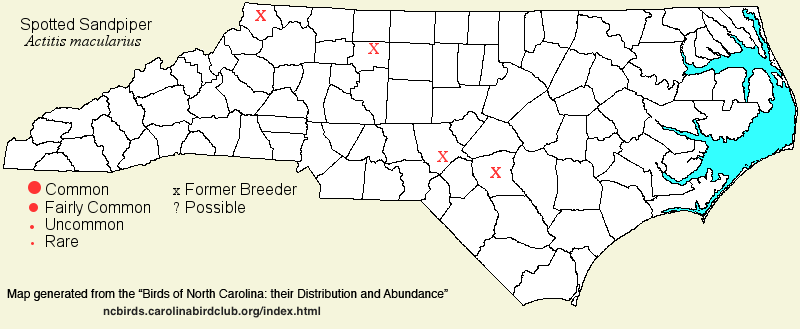 |  |
|
Spotted Sandpiper - Actitis macularius SCOLOPACIDAE Members: | Search Common: Search Scientific: |
|
|
|||||||
| General Comments | The Spotted Sandpiper is one of the most widespread shorebirds occurring during migration across the state, appearing along the shorelines of many or most ponds and lakes at one time or another. Unlike most others, they are not restricted to mudflats of large lakes in which to forage, but they can "make do" along the shores of small ponds, pools, lakes, river or creek sandbars, sewage ponds, and the like, even along tidal shores. It breeds across much of the continent, south to the northern half of the lower 48 states. The species has nested in North Carolina on scattered occasions, and perhaps does somewhere in our northern mountains in most years; however, nesting birds are somewhat secretive, and migrants linger in the state even into Jun, making proof of nesting difficult. Nesting takes place mainly along rivers and streams in the mountains, but sporadically around pond margins; nests are hidden in grass cover and are not easily seen. A few Spotteds occur in early winter close to the southeastern coast, and erratically elsewhere in the state; however, few are seen by late Jan or Feb, and thus it is difficult to say whether it is truly a winter resident in North Carolina. | ||||||
| Breeding Status | Sporadic Breeder | ||||||
| NC BRC List | Definitive | ||||||
| State Status | |||||||
| U.S. Status | |||||||
| State Rank | SZ | ||||||
| Global Rank | G5 | ||||||
| Coastal Plain | Transient and sparse winter visitor/resident, and accidental/casual breeder. Fairly common and widespread spring and fall migrant throughout the province, both coastally and inland, though scarce along tidal shores. In winter, rare along the southern coast, mainly Brunswick and New Hanover, and very rare to rare early winter visitor/straggler on the central and northern coastal areas; few birds likely overwinter in the state. Farther inland, rare into early winter across the region, and very rare in Jan-Feb. Mostly present from early Apr to late May, and mid-Jul to early Nov; small numbers are present in early summer, but there are just two or three known breeding records for the province. Two are from Thagard's Lake (Moore) -- a flightless juvenile with adults on 3 Jun 1967; and a nest with four eggs, and a juvenile seen later in the season, in May-Jun 1968. A third record of a likely nesting was near Fayetteville, where adults were seen all summer and several half-grown young were seen on 25 Jul 1986. Peak counts: 50, Shackleford Banks, 8 Jul 1972. | ||||||
| Piedmont | Transient, sparse winter visitor, and sporadic/casual breeder. Fairly common and widespread in both spring and fall migration; mainly late Mar to late May, and mid-Jul to late Oct, with a number of records in Jun; very rare to rare into Dec, and very rare in Jan-Feb. Nesting or presumed nesting from Winston-Salem, at two sites in 1993, and possibly there in 1997 (displaying/courting pair); each record is from a sewage treatment plant. Peak counts: 57, Tar River Reservoir (Nash), 16 May 2001. | ||||||
| Mountains | Transient, and apparent sporadic breeder (mostly presumed or unconfirmed); fairly common and widespread, though mainly below 4,000 feet elevation, in spring and fall; mainly mid-Apr to mid-Oct; apparently just three records in winter, two in Buncombe and one in Haywood. There have been scattered records from the New River in Ashe during the breeding season, and the species is presumed to have nested along the river, though no nest or young have been found. For example, one adult was "singing" on territory, New River at Weavers Ford (Ashe), 4 Jun 1981 [Chat 46:22 link]. A chick was seen at Swannanoa (Buncombe) on 20 Jun 1932 for the first conclusive breeding record in the state. Peak count: 20, Price Lake (Watauga), 7 May 1978. | ||||||
| Finding Tips |
A few can usually be seen in migration on the shorelines of ponds and lakes in many counties. *** | ||||||
| Attribution | LeGrand[2023-03-11], LeGrand[2020-04-18], LeGrand[2018-02-01] | ||||||
| NC Map Map depicts all counties with a report (transient or resident) for the species. | Click on county for list of all known species. |
| NC Breeding Season Map Map depicts assumed breeding season abundance for the species. |  |